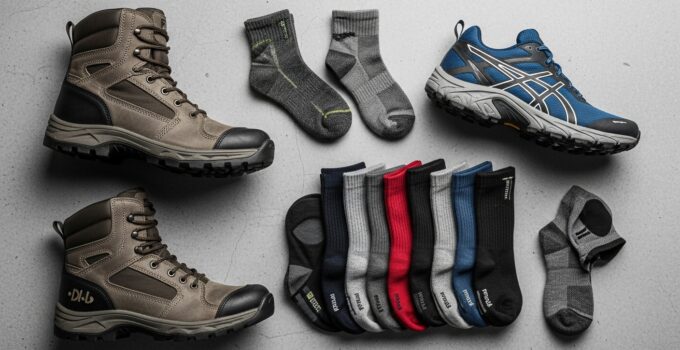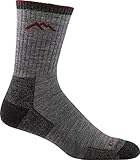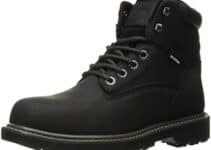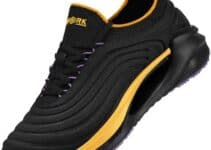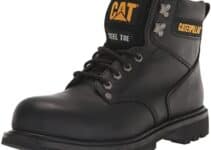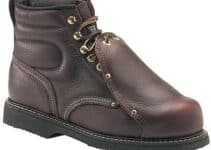Look, you probably just dropped a couple hundred bucks on a killer pair of tactical boots or high-tech trail runners. That’s great. Now, stop looking at that 6-pack of cheap cotton socks you bought at the convenience store.
You spent good money on the boots, but the socks are the true unsung heroes of your footwear system. As someone who has logged serious miles in everything from heavy rucks to nimble trail shoes, I’m telling you this straight: The #1 mistake that leads to blisters, hot spots, and general misery is wearing the wrong sock.
A quality performance sock isn’t an accessory; it’s a critical tool designed to manage friction and moisture. Here is the breakdown of the materials, cushioning, and specific models that will save your feet, whether you’re running a marathon or rucking 10 miles with a heavy pack.








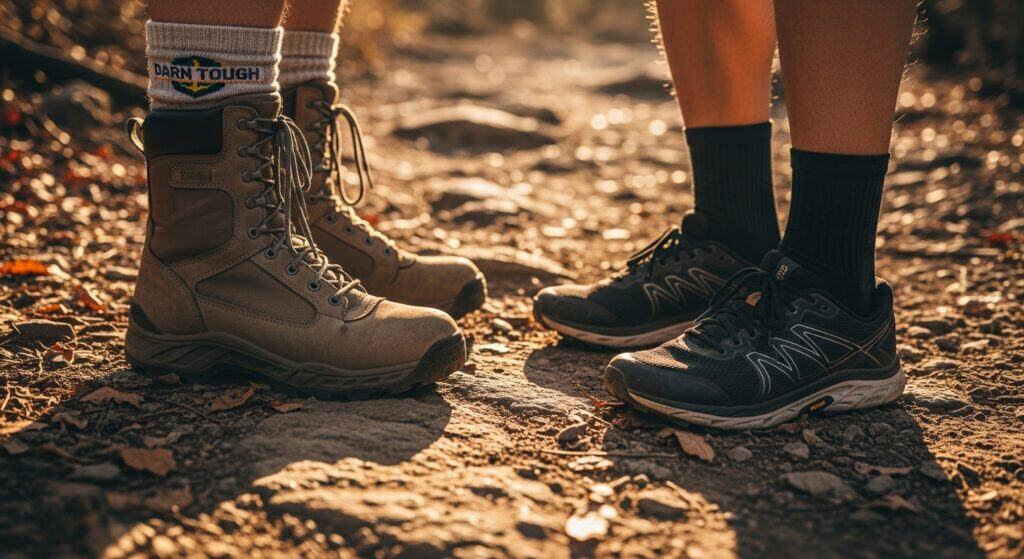
top tactical & trail socks
A high-performance sock is a critical tool, not an accessory. We tested the best.
Who This Guide Is For
This expert guide is for anyone who demands high-performance, blister-free results from their footwear system. This includes:
- Tactical Operators & Law Enforcement
- Military Personnel (especially for rucking and field use)
- Dedicated Ruckers & GoRuck participants
- Trail Runners & Fastpackers
- Hikers & Hunters in 6″ or 8″ boots
- Any worker who wears tactical-style boots and carries a heavy pack
At-a-Glance: Top Tactical & Trail Socks
| Sock Model | Material (Primary) | Cushion Level | Height | Best For |
|---|---|---|---|---|
| Darn Tough T4022 | Merino Wool / Nylon | Mid-Cushion | Boot (Mid-Calf) | Tactical, All-Purpose |
| Darn Tough T4033 | Merino Wool / Nylon | Full Cushion | Boot (Mid-Calf) | Heavy Rucking, Cold |
| Fox River Wick Dry | Polypropylene / Nylon | Mid-Cushion | Boot (Mid-Calf) | Hot Weather, Value |
| Lé Bent Trail 3/4 | Merino / Bamboo Rayon | Targeted (Light) | Crew | Trail Running (Comfort) |
| Injinji Trail Midweight | CoolMax (Polyester) | Mid-Cushion | Mini-Crew | Blisters Between Toes |
The Golden Rule: COTTON IS ROTTEN
Let’s get the most important piece of honest advice out of the way: Never, ever wear cotton socks in your boots or running shoes.
Cotton is a sponge. It soaks up sweat, holds that moisture against your skin, and then sags or bunches up, creating wrinkles. This wet, wrinkly fabric is a friction machine, and friction creates blisters—which are a mission-critical failure, whether you’re on a trail or a patrol.
For performance, you need technical materials that actively manage moisture.
A Guru’s Guide to Sock Tech (Materials, Fit & Height)
1. Materials: Merino Wool vs. Synthetics
This is the engine of the sock. It’s all about moisture management.
| Material | Pros | Cons |
|---|---|---|
| Merino Wool (The King) | Thermoregulating (cools in summer, warms in winter), moisture-wicking, and naturally odor-resistant. | Higher cost per pair, can take longer to air-dry than pure synthetics. |
| Synthetics (The Workhorse) | (Nylon, Polyester, Spandex, Coolmax®). Extremely durable, fast-drying, and provides the “elastic hug.” | Can hold odors more than wool (if not treated), not as “thermoregulating.” |
| Bamboo Rayon (The Newcomer) | Incredibly soft, lightweight, and wicks well. Often blended with Merino. | Less proven long-term durability than Nylon/Wool blends. |
The Verdict: The best performance socks are a blend. They combine Merino Wool (for comfort/wicking), Nylon (for durability), and Spandex/Lycra® (for fit).
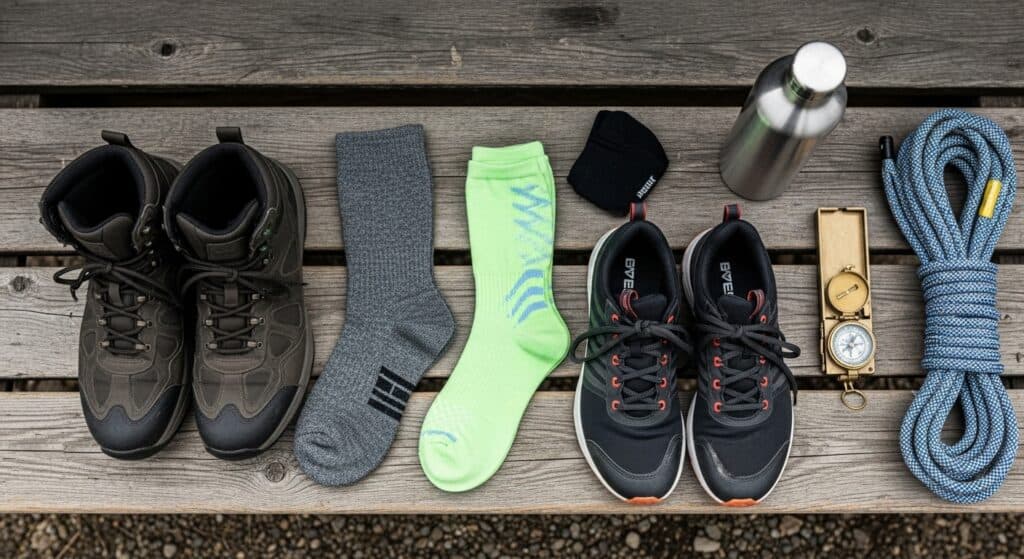
Fit is everything. A sock must be snug, with no wrinkles, to prevent blisters.
2. Fit is Everything: Height and Snugness
Your sock needs to work with your footwear. This means matching the height to the boot collar and ensuring a perfect, snug fit.
Sock Height: Cover That Boot Collar!
This is non-negotiable advice: Your sock must be taller than the collar of your boot to prevent the boot material from rubbing your skin raw.
| Your Boot Collar Height | Best Sock Height | Why? |
|---|---|---|
| Low-Cut (Trail Runner) | Micro-Crew / Quarter | Covers the ankle bone, prevents heel rub. |
| 6″ Boot (Hiker/Work) | Crew | Sits 6-8″ above the ankle, well above the collar. |
| 8″ Boot (Tactical/Military) | Boot / Mid-Calf | Sits mid-way up the calf, prevents all rubbing. |
| 10″+ Boot (Logger/Hunter) | Over-the-Calf (OTC) | Sits below the knee, won’t sag. |
How a Sock Should Fit (A Guru’s Guide)
The fit should be snug, but not tight. Any wrinkles or loose fabric are a future blister.
- No Heel Slipping: The heel pocket of the sock must sit perfectly on your heel. If it’s loose, it will bunch up.
- No Toe Compression: Your toes should have room to wiggle. If they are compressed, your feet will go numb.
- No Wrinkles: A well-fitting sock will be smooth against your skin. This is why the “elastic hug” from Spandex/Lycra® is so important.
3. Cushioning: Your First Line of Defense
This is the padding in key areas. What’s right for you depends on your boot’s fit and your activity.
- Light/Ultralight: Best for hot weather running or if your boots are already snug.
- Mid-Cushion (The All-Purpose Standard): This is the go-to for general hiking, tactical patrol, and most rucking. It protects your shin from uncomfortable lace pressure (a.k.a. “lace bite”).
- Full/Heavyweight: Only for two reasons: 1) Extreme cold, or 2) Carrying a heavy rucksack (50lb+). The extra cushion absorbs shock, but it takes up more volume in your boot.
Blister Defense: Specialized Sock Technology
If you’re doing everything right and still get blisters, you may need a specialized solution.
- Double-Layer Socks (e.g., Wrightsock): These are famously effective. The sock has two layers that move against each other, so the friction happens between the layers, not on your skin.
- Toe Socks (e.g., Injinji): If you get blisters between your toes, these are a game-changer. The individual toe sleeves prevent skin-on-skin rubbing.
- Liner Socks (The Two-Sock System): A pro-level technique for extreme, long-distance rucking. You wear a thin synthetic liner first, then your thicker wool sock over it.
Honest Take: For daily training, a single, high-quality sock is best. Use these specialized options only if you have a specific, recurring blister problem.
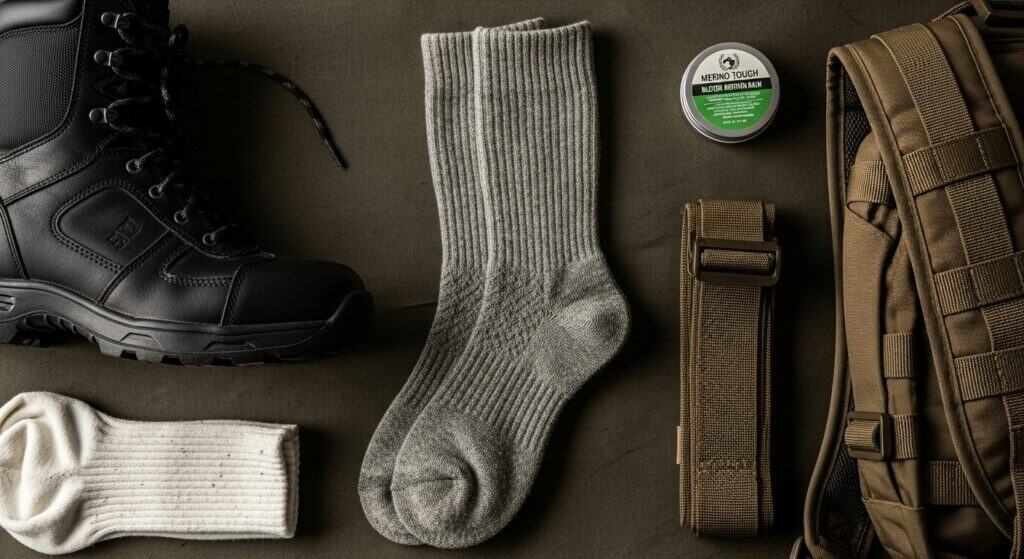
Tactical socks (left) prioritize durability and shin protection. Trail socks (right) prioritize light weight and breathability.
Top Recommended Socks for Tactical Boots & Rucking
This is for your 8-inch boots, heavy packs, and long days on patrol. Durability and support are the top priorities.
🏆 Best Overall: Darn Tough T4022 Midweight Tactical Boot Sock
The Honest Take: This is the consensus gold standard. It’s the sock countless military and law enforcement professionals trust. It has the perfect Merino/Nylon blend, ideal mid-cushioning for shin protection, and won’t slip or bunch. But the real feature is the unconditional lifetime guarantee. If you wear a hole in it, they replace it. Tough as nails.
Pros & Cons
| Pros | Cons |
|
|
🥾 Best for Heavy Rucking: Darn Tough T4033 Full Cushion Boot Sock
The Honest Take: This is the T4022’s big brother. It features dense full cushioning that wraps your entire foot and leg. This provides maximum shock absorption and insulation, making it the top choice for carrying heavy loads (50lb+) or for operating in extreme cold weather. Make sure your boots have enough room for this thicker sock.
Pros & Cons
| Pros | Cons |
|
|
💰 Best Value: Fox River Wick Dry Tactical Boot Sock
The Honest Take: Fox River is a long-time military supplier. This polypropylene-blend sock is a synthetic workhorse. Its Wick Dry® tech is fantastic at pulling liquid sweat off your foot (it’s hydrophobic), making it ideal for hot, humid environments. This is also the best value by a mile. You can often find a pair for $12-$15, which is nearly half the price of its premium Merino competitors ($25-$30). For building a full rotation of socks without breaking the bank, this is the smart move.
Pros & Cons
| Pros | Cons |
|
|
💨 Best for Running/PT in Boots: Smartwool Athlete Edition Run Crew
The Honest Take: If you’re doing high-intensity PT or running in your boots, you want light and fast. Smartwool wins on softness and its athletic, “body-mapped” feel. This sock has targeted cushioning (only where you need it) and mesh zones for maximum breathability. It’s a high-performance running sock built tall enough for a 6″ or 8″ boot.
Pros & Cons
| Pros | Cons |
|
|
Top Recommended Socks for Trail Runners & Fastpackers
If your “running boots” are actually mid-cut trail shoes or lightweight hikers, breathability and a seamless fit are your highest priorities.
🥇 Best Overall Trail Running: Lé Bent Targeted Cushion 3/4 Crew
The Honest Take: This was the surprise top pick in recent testing. It blends soft Bamboo Rayon and Merino Wool for a velvety-soft feel that is simply unmatched. It has excellent targeted cushioning and a secure fit that does not move on the trail, making it a fantastic all-around choice for comfort and blister prevention.
🦶 Best for Toe Blisters: Injinji Trail Midweight Mini-Crew
The Honest Take: If you always get blisters between your toes, stop reading and buy these. The unique five-toe design is the only thing that solves skin-on-skin friction. It uses CoolMax® fiber to wick sweat and is a proven solution for many runners and hikers who were ready to give up.
🛡️ Most Durable Trail Sock: Darn Tough Light Hiker Quarter/Micro Crew
The Honest Take: Want a sock for trail running that will also last 10 years? This is it. It’s the classic Darn Tough formula—Merino blend, durable, great fit—but in a lighter, lower-cut package for trail shoes. It’s comfortable, wicks moisture, and carries the legendary lifetime guarantee. An absolute workhorse.
Darn Tough vs. Smartwool: What’s the Real Difference?
Both brands are top-tier, made in the USA, and use premium Merino blends. If you are torn between the two, here is the honest advice based on testing and user reports:
- Darn Tough wins on Durability. Their socks feel denser, and the unconditional lifetime warranty is real—send back a pair with a hole, and they give you credit for a new one, no questions asked.
- Smartwool wins on Softness and Fit. Their Merino blends often feel softer next-to-skin, with more of an athletic, body-mapped fit, focusing on cushioning placement for specific activities.
How to Prevent Blisters: A 3-Step System
- Fix Your Socks: Wear a snug-fitting, non-cotton (Merino or Synthetic) sock.
- Fix Your Boots: Ensure your boots are broken in and fit correctly. A sloppy-fitting boot is a primary cause of blisters.
- → Need New Boots? See the Best Tactical Boots
- Fix Your Insoles (The Pro-Tip): A flat, stock insole can cause your foot to slide. Upgrading your insoles can lock your heel in place and provide critical arch support.
- → Find a Pair: Best Insoles for Running & Tactical Boots
Frequently Asked Questions (FAQ)
How often should I change my socks in the field?
If you’re on a multi-day operation, you should aim to change your socks at least once every 24 hours, or any time you have a long halt where you can air out your feet. A fresh, dry pair of socks is a massive morale and health booster. Always pack at least two extra pairs.
Darn Tough vs. Smartwool: What’s the real difference?
Both are top-tier. The general consensus is: Darn Tough wins on DURABILITY. Their lifetime warranty is legendary, and their socks feel dense and tough. Smartwool wins on SOFTNESS. Their Merino blends often feel a bit softer and more athletic, with more focus on body-mapping. You can’t go wrong with either.
Do I really need liner socks?
For most daily wear, no. A single, good-quality sock is better. But for long-distance, heavy-pack rucking (10+ miles), a two-sock system (thin synthetic liner + mid-cushion wool sock) is a proven method for preventing blisters. It’s a pro-level technique for extreme conditions.
Final Takeaway
Stop treating your socks as an afterthought. The $20–$30 you spend on a single pair of premium Merino wool or synthetic performance socks is the absolute best investment you can make in your personal gear.
A sock cannot fix a bad boot, but a bad sock will ruin a perfect boot. Choose a material that wicks moisture, match the height to your boot collar, and if you have blister issues, consider specialized options like toe socks or double layers. Your feet are your life in the field or on the trail—treat them like it.

